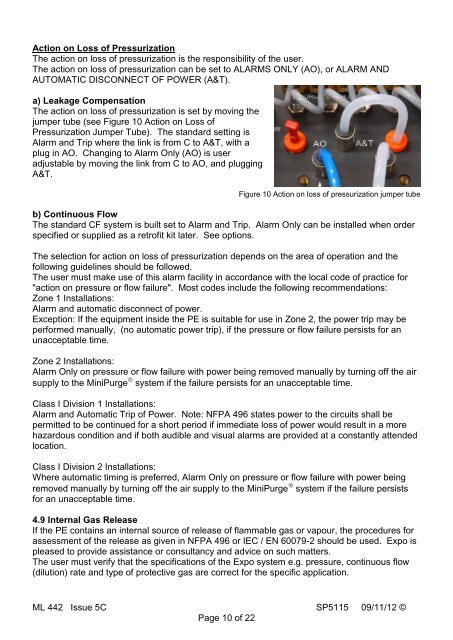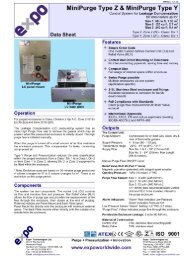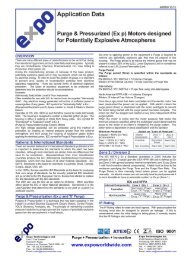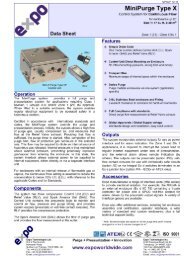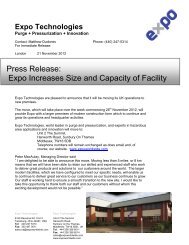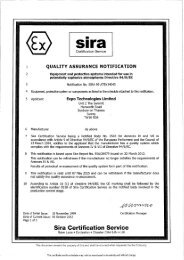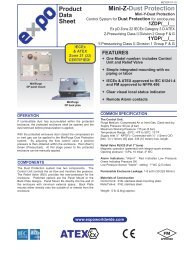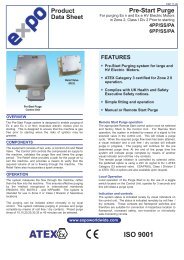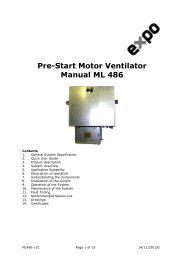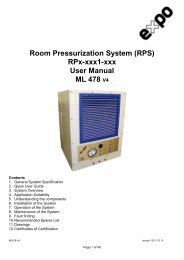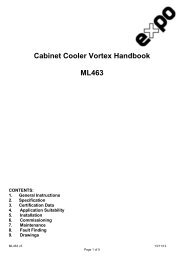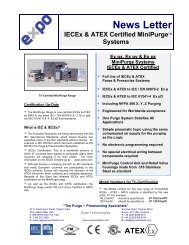Mini-X-Purge Size 1 Manual ML 442 - Expo Technologies
Mini-X-Purge Size 1 Manual ML 442 - Expo Technologies
Mini-X-Purge Size 1 Manual ML 442 - Expo Technologies
Create successful ePaper yourself
Turn your PDF publications into a flip-book with our unique Google optimized e-Paper software.
Action on Loss of Pressurization<br />
The action on loss of pressurization is the responsibility of the user.<br />
The action on loss of pressurization can be set to ALARMS ONLY (AO), or ALARM AND<br />
AUTOMATIC DISCONNECT OF POWER (A&T).<br />
a) Leakage Compensation<br />
The action on loss of pressurization is set by moving the<br />
jumper tube (see Figure 10 Action on Loss of<br />
Pressurization Jumper Tube). The standard setting is<br />
Alarm and Trip where the link is from C to A&T, with a<br />
plug in AO. Changing to Alarm Only (AO) is user<br />
adjustable by moving the link from C to AO, and plugging<br />
A&T.<br />
Figure 10 Action on loss of pressurization jumper tube<br />
b) Continuous Flow<br />
The standard CF system is built set to Alarm and Trip. Alarm Only can be installed when order<br />
specified or supplied as a retrofit kit later. See options.<br />
The selection for action on loss of pressurization depends on the area of operation and the<br />
following guidelines should be followed.<br />
The user must make use of this alarm facility in accordance with the local code of practice for<br />
"action on pressure or flow failure". Most codes include the following recommendations:<br />
Zone 1 Installations:<br />
Alarm and automatic disconnect of power.<br />
Exception: If the equipment inside the PE is suitable for use in Zone 2, the power trip may be<br />
performed manually, (no automatic power trip), if the pressure or flow failure persists for an<br />
unacceptable time.<br />
Zone 2 Installations:<br />
Alarm Only on pressure or flow failure with power being removed manually by turning off the air<br />
supply to the <strong>Mini</strong><strong>Purge</strong> � system if the failure persists for an unacceptable time.<br />
Class I Division 1 Installations:<br />
Alarm and Automatic Trip of Power. Note: NFPA 496 states power to the circuits shall be<br />
permitted to be continued for a short period if immediate loss of power would result in a more<br />
hazardous condition and if both audible and visual alarms are provided at a constantly attended<br />
location.<br />
Class I Division 2 Installations:<br />
Where automatic timing is preferred, Alarm Only on pressure or flow failure with power being<br />
removed manually by turning off the air supply to the <strong>Mini</strong><strong>Purge</strong> � system if the failure persists<br />
for an unacceptable time.<br />
4.9 Internal Gas Release<br />
If the PE contains an internal source of release of flammable gas or vapour, the procedures for<br />
assessment of the release as given in NFPA 496 or IEC / EN 60079-2 should be used. <strong>Expo</strong> is<br />
pleased to provide assistance or consultancy and advice on such matters.<br />
The user must verify that the specifications of the <strong>Expo</strong> system e.g. pressure, continuous flow<br />
(dilution) rate and type of protective gas are correct for the specific application.<br />
<strong>ML</strong> <strong>442</strong> Issue 5C SP5115 09/11/12 ©<br />
Page 10 of 22


